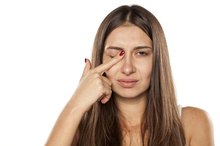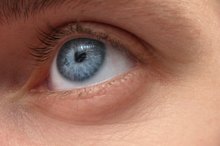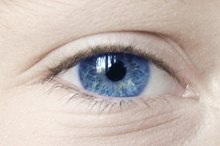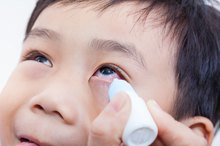Rosacea is a skin condition typically characterized by redness in the face, usually on the forehead, cheeks and nose. Blood vessels underneath the skin, known as telangiectasias, are often visible in affected areas. Rosacea is more common in adults than in children. It is more prevalent in women, with the exception of the rhinophyma form, in which the nose becomes bulbous in appearance due to inflammation; this is typically more common in men. Rosacea can also affect the eyes, which is known as ocular rosacea.
If you are experiencing serious medical symptoms, seek emergency treatment immediately.
Symptoms
The symptoms of ocular rosacea commonly include:
- chronic irritation
- redness
- burning
- photophobia
- dryness,
- the sensation of a foreign body in the eye
These symptoms are often caused by inflammation of the eyelid margins, a condition known as blepharitis, which can lead to insufficient or abnormal tear production from the meibomian glands located within the eyelids.
Treatment
Itchy Eyelash Follicles
Learn More
For mild blepharitis and ocular rosacea, applying a warm compress, such as a warm washcloth, over closed eyelids and massaging gently may help to soothe the eye area and alleviate symptoms. This procedure may be performed in the morning upon rising and in the evening before bed. Maintaining good ocular hygiene, by gently cleaning the eyelid margins with a mild baby shampoo or a specialized eyelid cleaner available over-the-counter, also helps to prevent or reduce inflammation. In some cases, however, prescription treatments such as:
- anti-inflammatories
- antibiotics
- in the form of eye drops
- ointments or oral medicines
- are often necessary
Medication may only be required for a short period of time or on as-needed basis, but it can help to improve or alleviate signs and symptoms for an extended period of time.
- For mild blepharitis and ocular rosacea, applying a warm compress, such as a warm washcloth, over closed eyelids and massaging gently may help to soothe the eye area and alleviate symptoms.
- In some cases, however, prescription treatments such as: * anti-inflammatories
* antibiotics
* in the form of eye drops
* ointments or oral medicines
* are often necessary Medication may only be required for a short period of time or on as-needed basis, but it can help to improve or alleviate signs and symptoms for an extended period of time.
Related Articles
References
- InformedHealth.org [Internet]. Cologne, Germany: Institute for Quality and Efficiency in Health Care (IQWiG); 2006-. Rosacea: Overview. 2006 Feb 14 [Updated 2018 Sep 20].Available from: https://www.ncbi.nlm.nih.gov/books/NBK279476/
- Mikkelsen CS, Holmgren HR, Kjellman P, et al. Rosacea: a Clinical Review. Dermatol Reports. 2016;8(1):6387. Published 2016 Jun 23. doi:10.4081/dr.2016.6387
- Arman A, Demirseren DD, Takmaz T. Treatment of ocular rosacea: comparative study of topical cyclosporine and oral doxycycline. Int J Ophthalmol. 2015;8(3):544–549. Published 2015 Jun 18. doi:10.3980/j.issn.2222-3959.2015.03.19
- Milner MS, Beckman KA, Luchs JI, et al. Dysfunctional tear syndrome: dry eye disease and associated tear film disorders - new strategies for diagnosis and treatment. Curr Opin Ophthalmol. 2017;27 Suppl 1(Suppl 1):3–47. doi:10.1097/01.icu.0000512373.81749.b7
- Benitez-Del-Castillo JM. How to promote and preserve eyelid health. Clin Ophthalmol. 2012;6:1689–1698. doi:10.2147/OPTH.S33133
- Downie LE, Craig JP. Tear film evaluation and management in soft contact lens wear: a systematic approach. Clin Exp Optom. 2017;100(5):438-458.
- Putnam CM. Diagnosis and management of blepharitis: an optometrist's perspective. Clin Optom (Auckl). 2016;8:71–78. Published 2016 Aug 8. doi:10.2147/OPTO.S84795
- Mantelli F, Di Zazzo A, Sacchetti M, Dianzani C, Lambiase A, Bonini S. Topical azithromycin as a novel treatment for ocular rosacea. Ocul Immunol Inflamm. 2013;21(5):371–377. doi:10.3109/09273948.2013.801991
- Luchs J. Azithromycin in DuraSite for the treatment of blepharitis. Clin Ophthalmol. 2010;4:681–688. Published 2010 Jul 30. doi:10.2147/opth.s6370
- Macsai MS. The role of omega-3 dietary supplementation in blepharitis and meibomian gland dysfunction (an AOS thesis). Trans Am Ophthalmol Soc. 2008;106:336–356.
- Valentín S, Morales A, Sánchez JL, Rivera A. Safety and efficacy of doxycycline in the treatment of rosacea. Clin Cosmet Investig Dermatol. 2009;2:129–140. Published 2009 Aug 12. doi:10.2147/ccid.s4296
- Giannaccare G, Taroni L, Senni C, Scorcia V. Intense Pulsed Light Therapy In The Treatment Of Meibomian Gland Dysfunction: Current Perspectives. Clin Optom (Auckl). 2019;11:113–126. Published 2019 Oct 17. doi:10.2147/OPTO.S217639
- Kabat, Alan and Diana Shechtman. Current Therapeutic Approaches to Blepharitis Managment, Review of Optometry, March 2011.
- Shovlin, Joseph. Pulsed Light for Ocular Rosacea, Review of Optometry, April 2011.
Writer Bio
Dr. Fox completed his Bachelor of Biological Sciences at Ohio University in 2000, and earned both his Master of Science and Doctorate of Optometry at The Ohio State University in 2004. He actively participates as a clinical trials investigator and he has presented his individual research at the Association for Research in Vision and Ophthalmology (ARVO). He has been a consultant for organizations such as Adena Health System and Inventiv Health. Dr. Fox currently is in private practice as a primary care optometrist in central Ohio, although he spent three years practicing and traveling extensively throughout Alaska. Dr. Fox has been a freelance writer for over ten years, and his work has been published by several media outlets including eHow, LIVESTRONG.COM, and The Times Gazette. More information and publications can be viewed at www.foxfreelancewriting.com.









